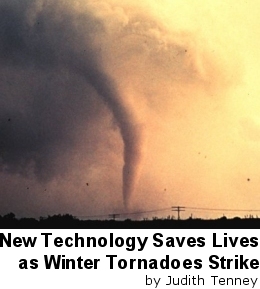![]()

![]()

![]()
![]()
![]()
In the dark cold
of the winter's night, shortly after midnight on February 14, 2000, at
least three tornadoes ripped through southwest Georgia, flattening the
homes of unsuspecting, sleeping residents, leaving rubble in their wake.
In the small town of Camilla, Georgia, the twisters cut a five-mile path
through a housing development south of town, killing 14 people and demolishing
at least 450 homes. "It's like somebody took a bulldozer and leveled
it," said volunteer firefighter Mike Newsome after he and his father
watched a large, dark funnel cloud dip down about three miles from their
home.
It's Not the SAME Old Story
The residents of Camilla, and officials at the National Weather Service (NWS), know that the disaster could have been even worse. "Following the nighttime tornadoes in Georgia…and in Oklahoma last May, people credited the advanced warning received from their NOAA Weather Radios with saving their lives," said Dennis McCarthy, meteorologist-in-charge of the NWS Norman, Oklahoma Forecast Office. NOAA Weather Radios, now equipped with digital technology called Specific Area Message Encoding (SAME) and battery back-up systems, provide early warning of severe weather, especially during the night, alerting residents to turn on their televisions and radios for detailed information. SAME technology allows NOAA Weather Radio to receive a tone alarm signal, triggering a built-in alarm to sound and the radio to turn itself on. It's new, and it's reducing lives lost, especially at night.